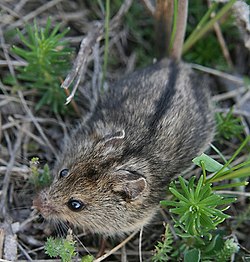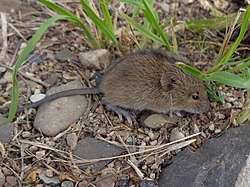List of sminthids

Sminthidae is a family of mammals in the order Rodentia and part of the Myomorpha suborder. Members of this family are called sminthids or birch mice. They are found in Asia and Europe, primarily in forests, shrublands, and grasslands, though some species can be found in wetlands. They are all of a similar size, ranging from 4–8 cm (2–3 in) long, plus a 6–12 cm (2–5 in) tail. Sminthids are omnivores and primarily eat seeds, berries, and insects.[1] No sminthids have population estimates, but the Hungarian birch mouse is categorized as endangered, while the Armenian birch mouse, Nordmann's birch mouse, and Severtzov's birch mouse are categorized as critically endangered.
The sixteen extant species of Sminthidae are all in a single genus. Several extinct prehistoric sminthid species have been discovered, though due to ongoing research and discoveries, the exact number and categorization is not fixed.[2]
Conventions
[edit]| Conservation status | |
|---|---|
| EX | Extinct (0 species) |
| EW | Extinct in the wild (0 species) |
| CR | Critically endangered (3 species) |
| EN | Endangered (1 species) |
| VU | Vulnerable (1 species) |
| NT | Near threatened (2 species) |
| LC | Least concern (9 species) |
The author citation for the species or genus is given after the scientific name; parentheses around the author citation indicate that this was not the original taxonomic placement. Conservation status codes listed follow the International Union for Conservation of Nature (IUCN) Red List of Threatened Species. Range maps are provided wherever possible; if a range map is not available, a description of the sminthid's range is provided. Ranges are based on the IUCN Red List for that species unless otherwise noted.
Classification
[edit]Sminthidae is a family consisting of sixteen extant species in a single genus, Sicista. This does not include hybrid species or extinct prehistoric species.
Sminthids
[edit]The following classification is based on the taxonomy described by the reference work Mammal Species of the World (2005), with augmentation by generally accepted proposals made since using molecular phylogenetic analysis, as supported by both the IUCN and the American Society of Mammalogists.[3]
| Common name | Scientific name and subspecies | Range | Size and ecology | IUCN status and estimated population |
|---|---|---|---|---|
| Altai birch mouse
|
S. napaea Hollister, 1912 |
Eastern Kazakhstan and southern Russia | Size: 6–8 cm (2–3 in) long, plus 8–11 cm (3–4 in) tail[4] Habitat: Shrubland and grassland[5] |
LC
|
| Armenian birch mouse
|
S. armenica Baskevich, 1988 |
Armenia | Size: About 7 cm (3 in) long, plus 9–11 cm (4 in) tail[6] Habitat: Grassland[7] |
CR
|
| Caucasian birch mouse
|
S. caucasica Vinogradov, 1925 |
Southwestern Russia and northern Georgia | Size: 4–7 cm (2–3 in) long, plus 8–11 cm (3–4 in) tail[6] Habitat: Grassland[8] |
NT
|
| Chinese birch mouse | S. concolor (Büchner, 1892) |
Central and western China | Size: 5–8 cm (2–3 in) long, plus 8–11 cm (3–4 in) tail[6] Habitat: Forest, shrubland, and grassland[9] |
LC
|
| Gray birch mouse
|
S. pseudonapaea Strautman, 1949 |
Eastern Kazakhstan and northwestern China | Size: 6–8 cm (2–3 in) long, plus 8–11 cm (3–4 in) tail[4] Habitat: Forest, shrubland, and grassland[10] |
LC
|
| Hungarian birch mouse | S. trizona (Frivaldszky, 1865) |
Hungary and Romania | Size: 5–7 cm (2–3 in) long, plus 6–10 cm (2–4 in) tail[4] Habitat: Grassland[11] |
EN
|
| Kazbeg birch mouse
|
S. kazbegica Sokolov, Baskevich, & Kovalskaya, 1986 |
Georgia and southwestern Russia | Size: 6–7 cm (2–3 in) long, plus 9–11 cm (4 in) tail[6] Habitat: Grassland[12] |
VU
|
| Kluchor birch mouse
|
S. kluchorica Sokolov, Kovalskaya, & Baskevich, 1980 |
Georgia and southwestern Russia | Size: 6–8 cm (2–3 in) long, plus 8–11 cm (3–4 in) tail[6] Habitat: Grassland[13] |
LC
|
| Long-tailed birch mouse
|
S. caudata Thomas, 1907 |
Eastern Russia and eastern China | Size: 6–8 cm (2–3 in) long, plus 9–12 cm (4–5 in) tail[6] Habitat: Forest and grassland[14] |
LC
|
| Nordmann's birch mouse
|
S. loriger (Nathusius, 1840) |
Eastern Europe and southwestern Russia | Size: 5–8 cm (2–3 in) long, plus 6–9 cm (2–4 in) tail[4] Habitat: Grassland[15] |
CR
|
| Northern birch mouse | S. betulina (Pallas, 1779) |
Central, eastern, and northern Europe and western Asia
|
Size: 5–8 cm (2–3 in) long, plus 8–10 cm (3–4 in) tail[4] Habitat: Forest, grassland, and inland wetlands[16] |
LC
|
| Severtzov's birch mouse
|
S. severtzovi Ogniov, 1935 |
Southwestern Russia
|
Size: 6–8 cm (2–3 in) long, plus 7–9 cm (3–4 in) tail[4] Habitat: Grassland[17] |
CR
|
| Southern birch mouse | S. subtilis (Pallas, 1773) |
Central Asia | Size: 5–8 cm (2–3 in) long, plus 7–9 cm (3–4 in) tail[4] Habitat: Shrubland and grassland[18] |
LC
|
| Strand's birch mouse
|
S. strandi (Formozov, 1931) |
Ukraine and southwestern Russia | Size: 6–8 cm (2–3 in) long, plus 8–11 cm (3–4 in) tail[4] Habitat: Forest and grassland[19] |
LC
|
| Tien Shan birch mouse
|
S. tianshanica (Zalensky, 1903) |
Central Asia | Size: 5–8 cm (2–3 in) long, plus 10–12 cm (4–5 in) tail[6] Habitat: Forest and grassland[20] |
LC
|
| Tsimlyansk birch mouse
|
S. cimlanica Kovalskaya, Tikhonov, Tikhonova, Surov, & Bogomolov, 2000 |
Ukraine and southwestern Russia | Size: Unknown[4] Habitat: Grassland[21] |
NT
|
References
[edit]- ^ Nowak, p. 1330
- ^ "Fossilworks: Dipodidae". Paleobiology Database. University of Wisconsin–Madison. Archived from the original on March 21, 2025. Retrieved September 8, 2025.
- ^ Wilson; Reeder, pp. 886-890
- ^ a b c d e f g h i Chernasky; Motis; Burgin, p. 205
- ^ a b Cassola, F. (2017) [errata version of 2016 assessment]. "Sicista napaea". IUCN Red List of Threatened Species. 2016 e.T20190A115157265. doi:10.2305/IUCN.UK.2016-3.RLTS.T20190A22204366.en.
- ^ a b c d e f g Chernasky; Motis; Burgin, p. 204
- ^ a b Rusin, M. (2020). "Sicista armenica". IUCN Red List of Threatened Species. 2020 e.T20185A22204773. doi:10.2305/IUCN.UK.2020-2.RLTS.T20185A22204773.en.
- ^ a b Shenbrot, G. (2020). "Sicista caucasica". IUCN Red List of Threatened Species. 2020 e.T20186A22204847. doi:10.2305/IUCN.UK.2020-2.RLTS.T20186A22204847.en.
- ^ a b Molur, S. (2017) [errata version of 2016 assessment]. "Sicista concolor". IUCN Red List of Threatened Species. 2016 e.T20188A115157138. doi:10.2305/IUCN.UK.2016-3.RLTS.T20188A22204686.en.
- ^ a b Cserkész, T. (2025). "Sicista pseudonapaea". IUCN Red List of Threatened Species. 2025 e.T20191A279719644.
- ^ a b Cserkész, T. (2024). "Sicista trizona". IUCN Red List of Threatened Species. 2024 e.T92332716A221786778. doi:10.2305/IUCN.UK.2024-2.RLTS.T92332716A221786778.en.
- ^ a b Cserkész, T.; Gazzard, A.; Shenbrot, G. (2025). "Sicista kazbegica". IUCN Red List of Threatened Species. 2025 e.T20189A278604388.
- ^ a b Kennerley, R. (2017). "Sicista kluchorica". IUCN Red List of Threatened Species. 2017 e.T20196A22204093. doi:10.2305/IUCN.UK.2017-2.RLTS.T20196A22204093.en.
- ^ a b Cserkész, T. (2025). "Sicista caudata". IUCN Red List of Threatened Species. 2025 e.T20187A279086628.
- ^ a b Rusin, M. (2024). "Sicista loriger". IUCN Red List of Threatened Species. 2024 e.T110500058A221790176. doi:10.2305/IUCN.UK.2024-2.RLTS.T110500058A221790176.en.
- ^ a b Meinig, H.; Zagorodnyuk, I.; Henttonen, H.; Zima, J.; Coroiu, I. (2017) [errata version of 2016 assessment]. "Sicista betulina". IUCN Red List of Threatened Species. 2016 e.T20184A115156920. doi:10.2305/IUCN.UK.2016-3.RLTS.T20184A22203739.en.
- ^ a b Rusin, M. (2024). "Sicista severtzovi". IUCN Red List of Threatened Species. 2024 e.T221733873A221734933. doi:10.2305/IUCN.UK.2024-2.RLTS.T221733873A221734933.en.
- ^ a b Cserkész, T.; Kennerley, R. (2018) [errata version of 2017 assessment]. "Sicista subtilis". IUCN Red List of Threatened Species. 2017 e.T91934441A123795199. doi:10.2305/IUCN.UK.2017-3.RLTS.T91934441A22204448.en.
- ^ a b Tsytsulina, K.; Formozov, N.; Zagorodnyuk, I.; Sheftel, B. (2017) [errata version of 2016 assessment]. "Sicista strandi". IUCN Red List of Threatened Species. 2016 e.T20193A115157429. doi:10.2305/IUCN.UK.2016-3.RLTS.T20193A22204276.en.
- ^ a b Cassola, F. (2016). "Sicista tianshanica". IUCN Red List of Threatened Species. 2016 e.T20195A22204006. doi:10.2305/IUCN.UK.2016-2.RLTS.T20195A22204006.en.
- ^ a b Rusin, M. (2024). "Sicista cimlanica". IUCN Red List of Threatened Species. 2024 e.T221732279A221732462. doi:10.2305/IUCN.UK.2024-2.RLTS.T221732279A221732462.en.
Sources
[edit]- Chernasky, Amy; Motis, Anna; Burgin, Connor, eds. (2023). All the Mammals of the World. Lynx Nature Books. ISBN 978-84-16728-66-4.
- Nowak, Ronald M. (1999). Walker's Mammals of the World. Vol. 2 (6th ed.). Johns Hopkins University Press. ISBN 978-0-8018-5789-8.
- Holder, Mary Ellen; Musser, Guy G. (2005). Wilson, Don E.; Reeder, DeeAnn M. (eds.). Mammal Species of the World. Vol. 2 (3rd ed.). Johns Hopkins University Press. ISBN 978-0-8018-8221-0.



